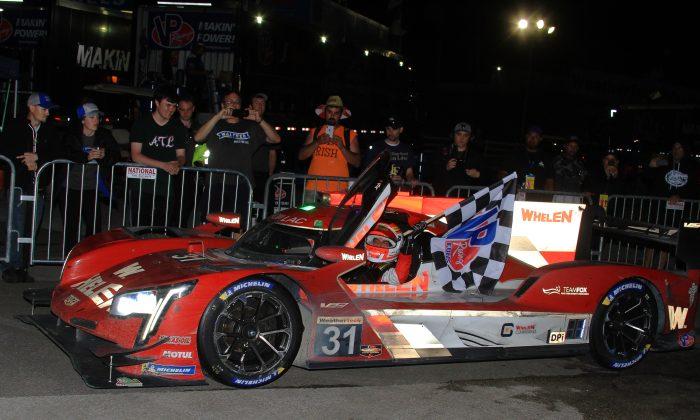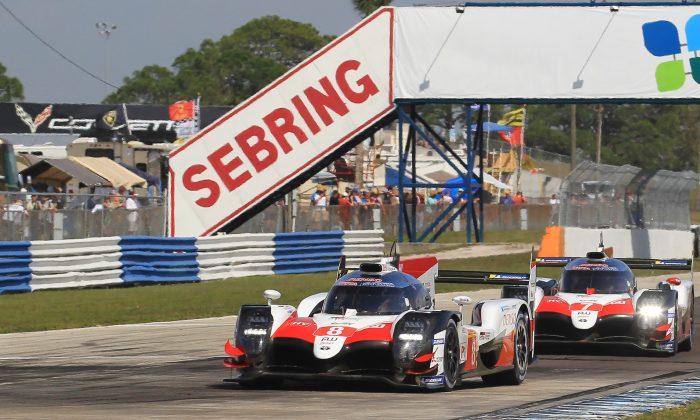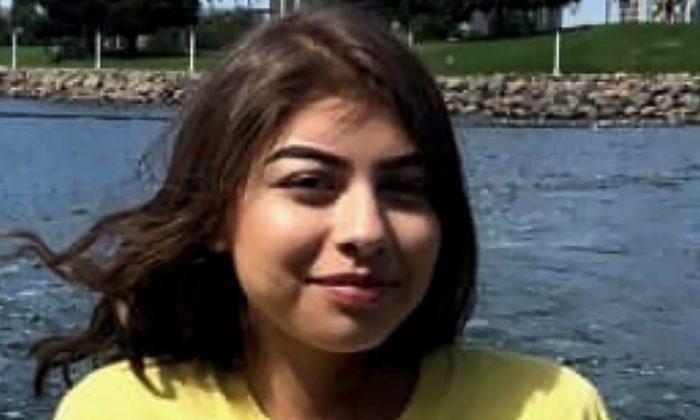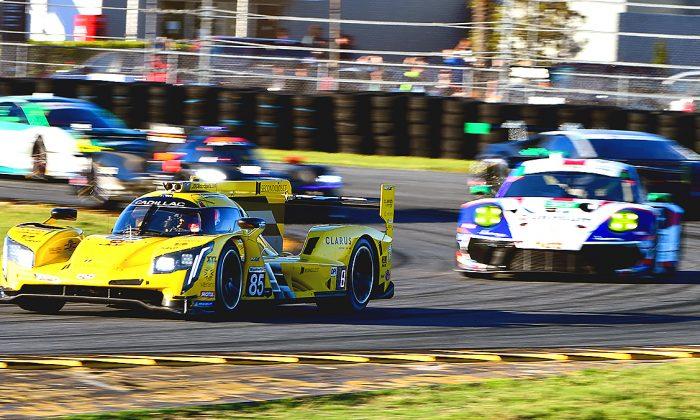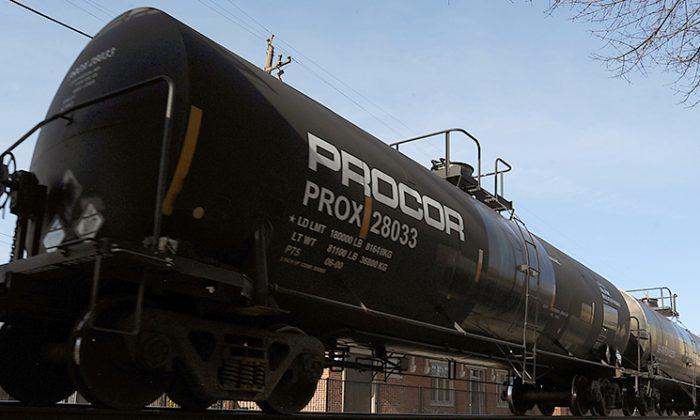SEBRING, Fla.—The Whelen Engineering racing team took its first overall win at the nation’s oldest sports-car endurance race on March 16—in part by hiring the driver who had won there two out of the three prior years.
The #31 Whelen Engineering Cadillac DPi-Vr finished first overall in the IMSA WeatherTech SportsCar Series 12 Hours of Sebring, it’s first win in that historic race. The victory left the 2018 champions tied for the 2019 title with the Wayne Taylor Racing team, which won the season opener at Daytona.
Over the off-season, Whelen hired Luis Felipe “Pipo” Derani, who piloted an Extreme Speed Motorsports Prototype to victory at the IMSA Sebring 12 Hours in 2016 and 2018. Derani worked his magic for Whelen, earning the squad its first and his third overall win in the storied 12-hour torture fest.

Derani, with co-drivers Felipe Nasr and Eric Curran, led 249 of the 348 laps completed, but the race was no runaway. Though the #31 had a 47-second lead with two hours to go, a caution bunched the field and the Whelen car never again led by more than a few seconds. A caution period fifteen minutes from the end led to a seven-minute shootout which Whelen won—but not by much.
Felipe Nasr crossed the finish line just one second ahead of Jordan Taylor in the #10 Wayne Taylor Racing Cadillac. Felipe Albuquerque was another three seconds back in the #5 Mustang Sampling Cadillac.

In Victory Circle, Derani said, “It’s unbelievable. I’m out of words right now. Man. This is amazing and it’s my third win in four years so I couldn’t be any happier.”
At the post-ceremony press conference Derani thanked the Whelen crew.
“It wouldn’t be without these guys first. My team, mechanics, everyone behind the scenes. They did a fantastic job. It was just one of those days that everything went perfect and we managed to get points for hour 4, hour 8 and get the win.”
“It’s a privilege to be driving for Cadillac and Whelen. And thank you, Action Express for giving me the opportunity to join them.”

Derani and company had to endure rain, chill, and the famously bad Sebring pavement—and did so with hardly an error. Reliability and speed are what it takes to win endurance races, and Whelen had both.
For Whelen, the Sebring win is one of the few titles the team has not taken in its brief three-seasons-and–two-races career. The team debuted in 2016 and won the prototype title, finished second in the championship in 2017 and won again in 2018, when it also won the North American Endurance Cup title.

Acura Slides, Mazda Burns, Cadillac Dominates
The inclement weather which rolled in during the final half hour of the World Endurance Championship race on Friday night (see World’s Fastest Sports Car Race at Sebring) stuck around until midday, making a mess of the first two hours of the IMSA race.The rain faded around noontime, but came back in short spurts throughout the race—just enough to wet the track and make the teams consider changing to rain tires, before moving on.

The track wasn’t safe for racing when the race officially started at 10:40 a.m. The first 11 laps were run under yellow so the drivers could learn where the worst of the standing water was located. Even at safety-car speed, the spray almost completely obliterated visibility behind Dane Cameron in the pole-sitting #6 Acura DPi.
Finally, 40 minutes later, race officials realized the rain, though seriously slackened, wasn’t going to stop. Sports cars race in the rain—drivers can modulate the throttle pedal to modulate safety—so at 11:20, the green flag waved and the racing began.

Tristan Nunez in the #77 Mazda DPi, which started second, immediately charged around the outside of Dane Cameron’s Acura in Turn One and took the lead.
Two laps later, Filipe Albuquerque in the #5 Mustang Sampling Cadillac DPI seized his chance when Nunez ran wide in Turn 7 and took the overall lead.
Five laps later Pipo Derani in the #31 Whelen Engineering Cadillac DPi slipped past the #5 Cadillac as it got mired in slower traffic, and assumed the lead, where the Whelen car remained for the next few hours.

The Acuras had razor-sharp handling on a dry track, which had allowed them to qualify first and third. In the wet, that handling proved unforgiving. The cars pitted for tire pressure adjustments, but still couldn’t keep pace. Te Acura set-up apparently didn’t work on a cold track, either. The #7 Acura managed to finish fourth, barely on the lead lap. The #6 came home ninth, nine laps down after losing time with electrical issues.
Mazda suffered its typical bad luck. At least one of the Multimatic-based, Mazda-powered RT24 DPis seems to burst into flame at every race, and at Sebring, it was the #77 which upheld the tradition.

The #77 Mazda was running strongly on lap 37, two hours, twenty minutes into the race when Timo Bernhard pulled over on the back straight with a cockpit fire. Bernhard sprinted down the track to grab a fire extinguisher, then ran back to save what he could of the car.
It turned out that a battery caused the fire—and Bernhard’s fast action prevented irreparable damage.
The #55 Mazda had contact in Hour Five and also lost laps. The #55 ended up finishing sixth, while the #77 made it home second to last, in 37th place—but at least it was running.

With the Mazdas losing time and the Acuras lacking pace, the front of the race was dominated by Cadillac. Six Cadillac DPis representing five teams (technically, four—Whelen and Mustang Sampling are both run by Action Express) started the race—and after four hours of racing, five of them held the top five spots.
The well-tested Dallara chassis and its low-stress, high-torque Cadillac V8 proved that is was still the best car in the Daytona Prototype international class. This was cemented later that night when Cadillac swept the podium.

At the end of the day, Cadillacs led all but two of the green-flag laps. The #6 Acura led 12 laps and was passed in the first turn after the race went green. Each Mazda led for one lap. The #31 Whelen Cadillac DP1 led 249 of 348 laps.
Despite the tough conditions, there were only five full-course cautions totaling one hour, forty minutes in the 12 hours—including the initial 11 laps—which is low by any standards.

Porsche Continues Sebring Dominance With GTLM Win
Porsche, fresh off sweeping both GTE-Pro and –Am in Friday’s WEC 8-hour race, followed up by winning in GTLM in Saturday’s IMSA-sponsored 12-Hour—giving the marque a total of 96 wins at that event since 1960.The #911 Porsche 911 RSR piloted by Nick Tandy, Patrick Pilet, Frank Makowiecki took the lead in the last hour of the race, passing Ryan Briscoe in the #67 Ford GT. Briscoe stayed on Tandy’s tail until the last yellow flag, 15 minutes from the end–and then spun shortly after the restart, trying to squeeze inside #44 GTD Lamborghini in Turn 15.

Briscoe’s spin gave Tandy a relatively free ride to victory. Joey Hand in the #66 Ford closed to within two seconds but never challenged in the final seven-minute shootout.

For Tandy, Pilet, and Makowiecki this was an anniversary win—the trio topped the GTLM class in last year’s 12 Hour as well. They are the first team of drivers in IMSA’s 50-year history to pull off this feat.
Despite Porsche topping qualifying—Pilet took the pole and Laurens Vanthoor in the #912 was second, though he was relegated for a technical violation—the cars were well off the pace through the wet hours of the race.
Both cars lost a lap to the field and five hours in, neither was in the top five. However, as the track dried and cooled, the Porsches sped up, while the Fords seemed to lose pace.

The #67 Ford led 270 of the 330 laps the GTLM cars ran. The #911 Porsche led only 30—but those laps included the final 18.
“It was like a roller coaster,” Patrick Pilet said in Victory lane. “After starting on the pole, I was last after the first stint. We knew the car was really fast in dry conditions. The car was consistent, we didn’t have tire deg. We were not quickest on one lap, but we managed to come back from nowhere.”
“We wrote another line on the Porsche story,” he concluded. “So it was nice to be part of that story.”

GTD: Grasser Wins the 36 Hours of Florida
Lamborghini showed its strength in North American endurance racing by backing up its win at the Rolex 24 with another at the Sebring 12 Hours.The #11 Grasser Racing Team Huracán GT3 of Mirko Bortolotti, Rik Breukers and Rolf Ineichen swept both endurance classics, earning the unofficial but coveted title of champion in the 36 Hours of Florida.
To sweeten the achievement, GRT is the first team to win the 36 Hours two years in a row.

After spending the first nine hours following the #9 Pfaff Porsche, the #11 Huracán started a two-hour battle with the #44 Magnus Racing Lamborghini. The pair traded the lead until finally Mirko Bortolotti opened a tiny gap on lap 297 (of 320 eventually completed.)
The final stint was an exercise in fuel-saving for both cars, until Bill Auberlen spun the #96 Turner Racing BMW with 15 minutes left. The final seven-minute match race went in Grasser’s favor, with the Magnus car crossing the line just under three seconds behind the Grasser car.
The #63 Scuderia Corsa Ferrari 488 GT3 completed the podium.

“It’s a great day; it’s unbelievable that we can win again at Sebring. It’s unbelievable,” said Rolf Ineichen
“For me it is an honor to the whole team. It was almost a perfect day. We didn’t have any issues. The strategy was perfect—it was a big gamble with the fuel strategy.”
It was a closer race than the time gap would indicate: the Grasser car was out of fuel at the finish.
“It’s really unbelievable,” Rik Breukers said from the podium. “Mirko did a fantastic job in the last 2 stints. He went in 6th and came out 1st.
“We just ran out of fuel on the last lap so we really did a great job getting it right.

As always, the GT Daytona class offered a multi-sided battle throughout the race—though for the first two-thirds, it was a battle for second.
The #9 Pfaff Racing Porsche spent half of the first 220 laps circulating in the lead of the GTD field, quietly keeping on the track and out of trouble. The team, which crashed late at Daytona, seemed on its way to redemption until an ABS sensor failed with about three hours left.
The Pfaff car nearly didn’t make the race at all. Driver Scott Hargrove stuffed the car into the tire barrier at Turn 14 during the morning warm-up. The crew managed to fix the car in two hours, and Hargrove and company seemed set to reward them with a class win, until the ABS failed.

Performance Tech Wins LMP2
LMP2 was a bit undersubscribed this year. Only two cars were entered: the #38 Performance Tech Oreca driven by Kyle Masson, Cameron Cassels, and series rookie Andrew Evans, squared off against the #52 PR1 Mathiasen Motorsports Oreca of Matthew McMurry, Gabriel Aubry, and Anders Fjorback.Matthew McMurry put the #52 on the pole with a lap only one-hundredth of a second faster than Kyle Masson’s in the #38, and the pair stayed about that close through the first couple of hours.
The close competition went away when, 2:21 into the race, the #52 suffered suspension failure exiting turn One. Driver Anders Fjorback had to limp his way around the entire 3.74-mile track to get the broken car back to the garages. The PR1 Oreca lost 13 laps, a margin it never reduced.

The Performance Tech team didn’t waste the gift luck had handed them. Neither drivers nor crew made a single mistake throughout the 12 Hours.
Performance Tech is no stranger to Sebring—the team has raced cars in a number of series here, and won the LMPC class at the 2017 12 Hours. This year’s LMP2 class win is the culmination of years of learning.
“The biggest thing for me was making sure the car stayed on track,” Andrew Evans explained, shortly after wining in his first IMSA outing.
“A few months ago, I never would have dreamt in a million years that I would win the Twelve Hours of Sebring. This is a lifetime dream come true; I am really excited about this. Kyle, Cameron, and the whole crew did a mega job all week.”
Evans revealed his secret advantage during the post-race press conference: “I think the biggest thing was the mental game,” he said. “In the rain, you had to be smart.
“Luckily I come from Seattle where you’re driving in the rain all the time growing up.

On to Long Beach
IMSA’s WeatherTech SportsCar Championship transitions from the two longest races on the schedule right into the shortest—the Bubba Burger Sports Car Grand Prix on the two-mile, 11-turn Long Beach, California street circuit.Because the course is so short and tight, only the DPi and GTLM classes will be racing. A total of 19 cars are entered.
There will be two practice sessions before qualifying on Friday, April 12. The green flag waves at 5:05 p.m. EDT on April 13 to start the one hour, forty-minute race.
The race will be broadcast on NBCSN starting at 5 p.m. Qualifying and, for those not geo-blocked, the race will be online at IMSA.tv. Qualifying starts at 8:30 p.m. on the 12th.






.
.
.
.
.
.
